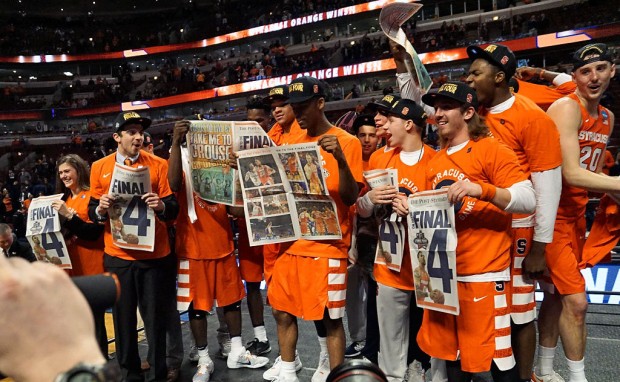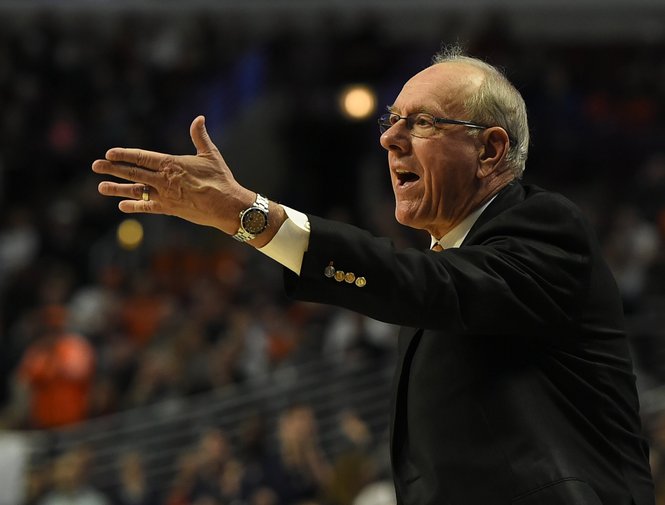
Syracuse: The Least Endearing Cinderella
Four teams in NCAA history have made the Final Four as a double-digit seed: LSU in 1986, George Mason in 2006, VCU in 2011, and Syracuse this year. The ‘Cuse is in the midst of a run that literally no one predicted; there was a more than good chance that they would even make the tournament before Selection Sunday.
They eked by as a 10 seed and blew by Dayton and Middle Tennessee State, straight into a matchup with the talented Gonzaga Bulldogs. Freshman Tyler Lydon blocked a jumper with two seconds left to seal a 63-60 victory and conjure images of Hakeem Warrick’s championship-winning block in 2003. They then staged a 29-8 run in the final ten minutes to come all the way back to a 68-62 victory against top-seeded Virginia and secured a trip to the Final Four, the only team not seeded first or second to get there this year.
This scrappy Syracuse team has effectively become the team to root for this coming weekend as they face ACC compatriot North Carolina for a berth in the National Championship. The fact that the program has been punished for various infractions over the past decade this season is not lost on the minds of the public, either. The team self-imposed a postseason ban last year, lost twelve scholarships over the next four years, starting this year, and Head Coach Jim Boeheim was suspended for nine games earlier in the year, which is partly to blame for his team’s downswing this season. America’s motto for the Final Four should be “All for one, and one for Orange!”

I’m definitely going to root for Syracuse, no doubt about it, but not because they’re the darlings of the dance. They’ve impressed me all season long, even in defeat (shout out: St. John’s University for taking them down this winter). Besides that, my bracket is busted anyway, especially after Michigan State wet the bed against MTSU, so why not root for competitive games?
The one thing that Syracuse is not, to me, is shocking. We need to remember that this is the same Syracuse team, coached by the same Jim Boeheim, that has been to 32 NCAA tournaments during his reign and dominated the BIG EAST for almost 40 years before switching to the ACC three years ago.
On the court, it’s nearly impossible to bet against Boeheim’s patented 2-3 zone, which he has perfected over the course of his lifetime at the helm. This season, with Boeheim absent from the sideline for about a quarter of his team’s games, the Orange still ranked in the top 25 in the country in scoring defense. They allow their opponents to shoot the ball at just under 41 percent, and just under 31 percent from three, absurdly low numbers even for a team that doesn’t have one nationally recognized talent (yet-keep an eye on Richardson).
It’s a foregone conclusion that a Syracuse team will, at the very least, play defense, and that’s what wins championships: 18 of the last 20 national champions had a defense that held opponents to either under 44% shooting or under 65 points per game (note: this information is not available for the 2000-2001 Duke Blue Devils, who ranked 11th in the nation in defensive efficiency). That takes a great amount of the magic out of their ongoing Final Four run.

The only way anyone could be shocked by a Syracuse tournament run is if they think that the roster was that depleted by the infractions. Let’s face it, though. Syracuse is a national powerhouse, and they’ll still find a way to get the talent that they need. Even still, most of their major contributors are graduate students and seniors, like Michael Gbinije, who averaged nearly 18 points per game, and Trevor Cooney, who plays 36 minutes per game.
The Orange were still able to land four-star recruit Malachi Richardson, who scored 23 points and led the second-half comeback against Virginia, and Lydon, who has had at least five blocks in three of the four NCAA tournament games he’s played in so far. Syracuse, despite the scholarship loss, has recruited and will continue to recruit some the best talent in the Northeast, and some of the best in the country.
It comes as little surprise that Syracuse came out of the Midwest after Michigan State embarrassed themselves against MTSU, either. The top four seeds in that region that survived the first round- Virginia, Utah, Iowa State, and Butler- have made a combined 81 appearances in the NCAA tournament. That sound pretty good, but Syracuse itself has made 39 appearances in the Big Dance in school history, far better than the pace set forth by the other three schools. The Midwest Region had one of the weaker number one seeds (UVA), but perhaps the strongest number two seed (MSU), with whom Syracuse would’ve had a date with in the second round. Once Middle Tennessee miraculously took care of business, Syracuse’s odds for victory increased.
For the mainstream media, the Syracuse “cinderella” run is a great story. Lyon, Richardson, Gbinije, and the rest of their cast of characters will get more than enough screen time on ESPN and FS1. However, the glass slipper never has, doesn’t currently, and never will, fit the program run by Boeheim because of the culture they’ve been able to create.







